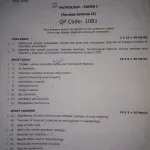RGUHS question papers are essential for students preparing for exams under Rajiv Gandhi University of Health Sciences. They help understand the exam pattern, types of questions, and important topics. This guide provides detailed questions and answers for all subjects to aid in effective learning and revision.
Medical Subjects
Question: What is the normal range of hemoglobin in adults?
Answer: The normal range of hemoglobin in adults is 13.5-17.5 g/dL for men and 12.0-15.5 g/dL for women.
Question: Define hypertension.
Answer: Hypertension is a condition where the blood pressure consistently remains above 140/90 mmHg.
Question: What is the role of insulin in the human body?
Answer: Insulin regulates blood sugar levels by facilitating the uptake of glucose into cells.
Question: What are the main types of blood cells?
Answer: The main types of blood cells are red blood cells, white blood cells, and platelets.
Question: What is the function of the liver in metabolism?
Answer: The liver processes nutrients, detoxifies harmful substances, and produces bile for fat digestion.
Question: What is anemia?
Answer: Anemia is a condition where the body lacks enough healthy red blood cells to carry oxygen effectively.
Question: Define myocardial infarction.
Answer: Myocardial infarction, commonly known as a heart attack, occurs when blood flow to the heart muscle is blocked.
Question: What are the stages of wound healing?
Answer: The stages are hemostasis, inflammation, proliferation, and remodeling.
Question: What is the purpose of vaccination?
Answer: Vaccination stimulates the immune system to develop immunity against specific diseases.
Question: What is the difference between a bacterial and a viral infection?
Answer: Bacterial infections are caused by bacteria and can often be treated with antibiotics, while viral infections are caused by viruses and usually require antiviral medication or supportive care.
Question: Define diabetes mellitus.
Answer: Diabetes mellitus is a metabolic disorder characterized by high blood glucose levels due to insufficient insulin production or insulin resistance.
Question: What are the common symptoms of tuberculosis?
Answer: Common symptoms include persistent cough, weight loss, fever, and night sweats.
Question: What is the role of the kidney in the human body?
Answer: The kidney filters waste products and excess fluids from the blood to form urine.
Question: What is the main function of the respiratory system?
Answer: The respiratory system facilitates the exchange of oxygen and carbon dioxide between the body and the environment.
Question: What are the common side effects of antibiotics?
Answer: Common side effects include nausea, diarrhea, allergic reactions, and yeast infections.
Question: Define osteoarthritis.
Answer: Osteoarthritis is a degenerative joint disease characterized by the breakdown of cartilage and underlying bone.
Question: What is the difference between systolic and diastolic blood pressure?
Answer: Systolic pressure measures the force of blood against artery walls during heartbeats, while diastolic pressure measures it between beats.
Question: What are the types of immunity?
Answer: The types of immunity are innate (natural) immunity and adaptive (acquired) immunity.
Question: What is a biopsy?
Answer: A biopsy is a medical procedure where a small sample of tissue is removed for examination to diagnose a disease.
Question: What is the function of hemoglobin?
Answer: Hemoglobin carries oxygen from the lungs to tissues and returns carbon dioxide from tissues to the lungs.
Dental Subjects
Question: What is dental caries?
Answer: Dental caries is tooth decay caused by the breakdown of tooth enamel due to acids produced by bacteria.
Question: Define gingivitis.
Answer: Gingivitis is the inflammation of the gums caused by plaque buildup around the teeth.
Question: What is the role of fluoride in oral health?
Answer: Fluoride strengthens tooth enamel and prevents cavities by making teeth more resistant to acid attacks.
Question: What is a root canal?
Answer: A root canal is a dental procedure to treat infection or damage inside the tooth by removing the pulp and sealing the tooth.
Question: Define malocclusion.
Answer: Malocclusion is the misalignment of teeth or an improper bite.
Question: What are the stages of periodontal disease?
Answer: The stages are gingivitis, mild periodontitis, and advanced periodontitis.
Question: What is bruxism?
Answer: Bruxism is the involuntary grinding or clenching of teeth, often during sleep.
Question: What are the common causes of halitosis?
Answer: Common causes include poor oral hygiene, gum disease, dry mouth, and certain foods.
Question: Define pulpitis.
Answer: Pulpitis is the inflammation of the dental pulp, often caused by tooth decay or trauma.
Question: What is the difference between a crown and a filling?
Answer: A crown covers and protects a damaged tooth, while a filling restores the function of a tooth with minor decay or damage.
Question: What is the function of saliva in oral health?
Answer: Saliva helps cleanse the mouth, digest food, and prevent tooth decay by neutralizing acids.
Question: What is orthodontics?
Answer: Orthodontics is a branch of dentistry that deals with correcting misaligned teeth and jaws.
Question: Define tooth erosion.
Answer: Tooth erosion is the loss of tooth enamel caused by acid attacks from foods, drinks, or stomach acid.
Question: What is the role of plaque in dental diseases?
Answer: Plaque is a sticky film of bacteria that can cause cavities and gum disease if not removed.
Question: What are dental implants?
Answer: Dental implants are artificial tooth roots placed into the jawbone to support replacement teeth.
Question: Define temporomandibular joint (TMJ) disorder.
Answer: TMJ disorder is a condition affecting the jaw joint, causing pain, difficulty chewing, and clicking sounds.
Question: What is a dental bridge?
Answer: A dental bridge is a fixed prosthetic device used to replace missing teeth by anchoring to adjacent teeth.
Question: What is the purpose of scaling and root planing?
Answer: Scaling and root planing remove plaque and tartar from teeth and smooth the root surfaces to prevent bacteria buildup.
Question: What are the common types of dental x-rays?
Answer: Common types include bitewing, periapical, panoramic, and occlusal x-rays.
RGUHS question papers and answers are invaluable tools for mastering exam topics in medical, dental, and allied health sciences. By exploring diverse questions across subjects, students can confidently prepare for their exams, ensuring a comprehensive understanding of key concepts. This guide supports focused learning for academic success.
Latest Posts
- Step-by-step guide to download and apply for jee mains admit card 202
- Comprehensive 2025 government holidays and recruitment details for job seekers
- JEE Mains Admit Card 2025: Your Step-by-Step Guide to Downloading the Hall Ticket
- Everything You Need to Know About 2025 Government Holidays Recruitment
- Comprehensive Guide to rrb d group recruitment 2025 – Eligibility, Vacancies, and Application
- Detailed guide to nps trust recruitment 2025 vacancies, eligibility and apply process
- Comprehensive guide to hpcl recruitment 2025 notification, vacancies, and application process
- ignou bed admission 2025 complete recruitment guide with eligibility and process
- Comprehensive Guide to Indian Army Agniveer Recruitment 2025 Notification and Jobs
- Everything You Must Know About CBSE Board Exams 2025 Changes & New Rules






